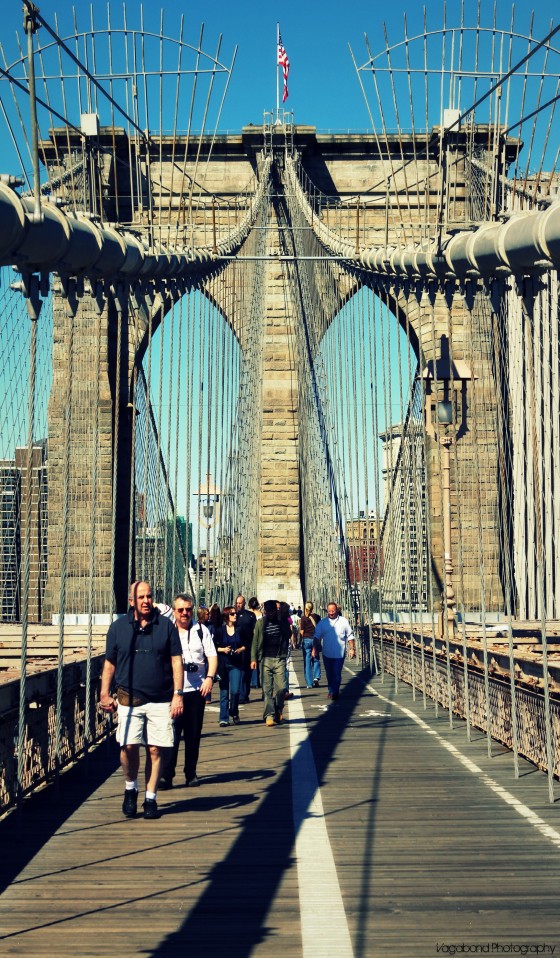 This morning as I was researching today’s post on the Brooklyn Bridge I was reminded of one of my favourite John Hiatt songs, Have a Little Faith in Me. With his gravelly voice in my head and perhaps my favourite shot from The Great New York Adventure, above, hanging freshly framed above my desk, I sat down to find out the story behind the construction of one of the most visually stunning man-made wonders of this world. On the day I took the shot above, it was a warm, brilliantly sunny, early October New York Saturday. I had already visited the iconic Empire State Building, Greenwich Village and Ground Zero. I was saving the best for last. Any photographer would tell you that a favourite shot while in New York has to be the Brooklyn Bridge. It is architecturally and graphically loaded with potential! There are lines and cables zig-zagging everywhere forcing you to look up, up, and up. I can still feel the hot sun on my head and the brilliant sense of freedom I felt while crossing the bridge, camera at the ready, adventure at hand. My. Best. Day. Ever! I should have guessed that a structure this grand, this imposing and impressive, would have a compelling creation story.
This morning as I was researching today’s post on the Brooklyn Bridge I was reminded of one of my favourite John Hiatt songs, Have a Little Faith in Me. With his gravelly voice in my head and perhaps my favourite shot from The Great New York Adventure, above, hanging freshly framed above my desk, I sat down to find out the story behind the construction of one of the most visually stunning man-made wonders of this world. On the day I took the shot above, it was a warm, brilliantly sunny, early October New York Saturday. I had already visited the iconic Empire State Building, Greenwich Village and Ground Zero. I was saving the best for last. Any photographer would tell you that a favourite shot while in New York has to be the Brooklyn Bridge. It is architecturally and graphically loaded with potential! There are lines and cables zig-zagging everywhere forcing you to look up, up, and up. I can still feel the hot sun on my head and the brilliant sense of freedom I felt while crossing the bridge, camera at the ready, adventure at hand. My. Best. Day. Ever! I should have guessed that a structure this grand, this imposing and impressive, would have a compelling creation story.
One could summarize this story with one sentence: behind every good man is a great woman! With my handy Wikipanion iPad app and beautiful Christmas gift, New York: Portrait of a City as my guides, I learned that the Brooklyn Bridge was initially designed by John Augustus Roebling and the project carried out by not only his son Washington Roebling, but also Washington’s capable wife Emily Warren Roebling. Shortly after beginning construction in 1870 Washington fell ill with decompression sickness (a.ka. the bends) caused by his time spent under water finding a secure spot to lay the foundation or caissons for the bridge. Emily stepped into the breach learning the intricacies of materials, cable construction and mathematics to help supervise the bridge’s construction over the next 13 years. The bridge, at the time the longest suspension bridge in the world, was officially opened for use on May 24, 1883, but not without controversy…
Not only had 27 workers lost their lives to decompression sickness during construction but one week after the bridge’s opening 12 people were killed in a stampede as a result of a rumour that the bridge was unsafe. One year later now legendary P.T. Barnum helped Roebling’s cause by making a public statement: he and his famous elephant Jumbo led a procession of 21 elephants across the bridge proving its safety once and for all. In fact, the pedestrian walkway has been used many times throughout the bridge’s history as the only means to cross the East River when all other options are unavailable. You might remember the most recent occurrence…the mass exodus of Manhattan across the bridge on September 11, 2001. A vivid image indeed.
At the time of its construction, the Brooklyn Bridge was a vivid image of technological wonder and optimism. Building such a structure required bending the laws of physics and mathematics to human will. In the article Opening Ceremonies of the New York and Brooklyn Bridge, May 24, 1883, bridge contractor William C. Kingsly eloquently writes about the national significance of the opening of the Brooklyn Bridge: “The occurrence was recognized as one of National importance; and throughout the Union, from the rocky headlands of Maine to the golden shores of the Pacific, and from the gleaming waters of the St. Lawrence to the vast expanse of the Mexican Gulf, the opening ceremonies were regarded with intelligent concern and approval. Nearly every State contributed its representatives to the swelling throng that attended, while those who were unable to be present contemplated with pride and satisfaction the completion and consecration to its purpose of the greatest engineering work of modern times.”
A suitable tribute to Washington and Elizabeth Roebling, who’s great leap of engineering faith has stood the test of time, providing safe passage to all that need it…and…a memory-soaked photo for one red-headed Vagabond Photographer.


 Hi, I’m Patti, wonderer, wanderer and photographer. During the week I’m a marketer in the publishing industry and on weekends I take to the road to explore this beautiful planet we live on.
Hi, I’m Patti, wonderer, wanderer and photographer. During the week I’m a marketer in the publishing industry and on weekends I take to the road to explore this beautiful planet we live on. 